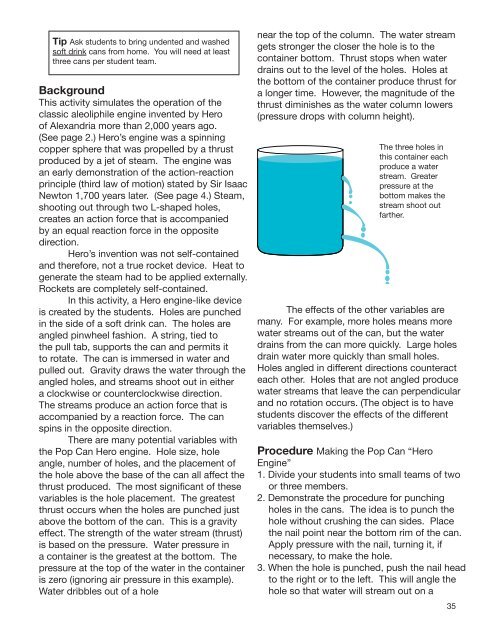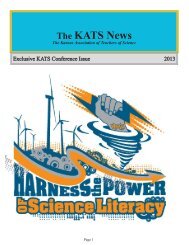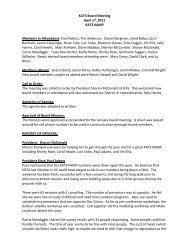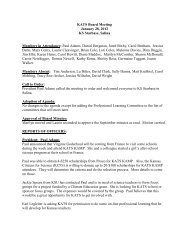Create successful ePaper yourself
Turn your PDF publications into a flip-book with our unique Google optimized e-Paper software.
Tip Ask students to bring undented and washed<br />
soft drink cans from home. You will need at least<br />
three cans per student team.<br />
Background<br />
This activity simulates the operation of the<br />
classic aleoliphile engine invented by Hero<br />
of Alexandria more than 2,000 years ago.<br />
(See page 2.) Hero’s engine was a spinning<br />
copper sphere that was propelled by a thrust<br />
produced by a jet of steam. The engine was<br />
an early demonstration of the action-reaction<br />
principle (third law of motion) stated by Sir Isaac<br />
Newton 1,700 years later. (See page 4.) Steam,<br />
shooting out through two L-shaped holes,<br />
creates an action force that is accompanied<br />
by an equal reaction force in the opposite<br />
direction.<br />
Hero’s invention was not self-contained<br />
and therefore, not a true <strong>rocket</strong> device. Heat to<br />
generate the steam had to be applied externally.<br />
Rockets are completely self-contained.<br />
In this activity, a Hero engine-like device<br />
is created by the students. Holes are punched<br />
in the side of a soft drink can. The holes are<br />
angled pinwheel fashion. A string, tied to<br />
the pull tab, supports the can and permits it<br />
to rotate. The can is immersed in water and<br />
pulled out. Gravity draws the water through the<br />
angled holes, and streams shoot out in either<br />
a clockwise or counterclockwise direction.<br />
The streams produce an action force that is<br />
accompanied by a reaction force. The can<br />
spins in the opposite direction.<br />
There are many potential variables with<br />
the Pop Can Hero engine. Hole size, hole<br />
angle, number of holes, and the placement of<br />
the hole above the base of the can all affect the<br />
thrust produced. The most significant of these<br />
variables is the hole placement. The greatest<br />
thrust occurs when the holes are punched just<br />
above the bottom of the can. This is a gravity<br />
effect. The strength of the water stream (thrust)<br />
is based on the pressure. Water pressure in<br />
a container is the greatest at the bottom. The<br />
pressure at the top of the water in the container<br />
is zero (ignoring air pressure in this example).<br />
Water dribbles out of a hole<br />
near the top of the column. The water stream<br />
gets stronger the closer the hole is to the<br />
container bottom. Thrust stops when water<br />
drains out to the level of the holes. Holes at<br />
the bottom of the container produce thrust for<br />
a longer time. However, the magnitude of the<br />
thrust diminishes as the water column lowers<br />
(pressure drops with column height).<br />
The three holes in<br />
this container each<br />
produce a water<br />
stream. Greater<br />
pressure at the<br />
bottom makes the<br />
stream shoot out<br />
farther.<br />
The effects of the other variables are<br />
many. For example, more holes means more<br />
water streams out of the can, but the water<br />
drains from the can more quickly. Large holes<br />
drain water more quickly than small holes.<br />
Holes angled in different directions counteract<br />
each other. Holes that are not angled produce<br />
water streams that leave the can perpendicular<br />
and no rotation occurs. (The object is to have<br />
students discover the effects of the different<br />
variables themselves.)<br />
Procedure Making the Pop Can “Hero<br />
Engine”<br />
1. Divide your students into small teams of two<br />
or three members.<br />
2. Demonstrate the procedure for punching<br />
holes in the cans. The idea is to punch the<br />
hole without crushing the can sides. Place<br />
the nail point near the bottom rim of the can.<br />
Apply pressure with the nail, turning it, if<br />
necessary, to make the hole.<br />
3. When the hole is punched, push the nail head<br />
to the right or to the left. This will angle the<br />
hole so that water will stream out on a<br />
35










